TOUCH
The action of a piano controls how the keys mechanically operate. Unlike a violinist who can control the strings directly with their fingers, a pianist must rely on the precision of the action to help shape the sound. Kawai’s exclusive Millennium III and Ultra-Responsive actions utilize 21st century materials and innovative designs to create a piano action worthy of the finest pianists.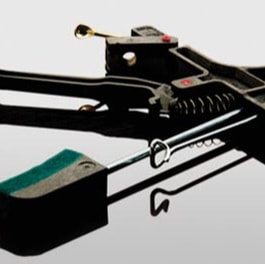 Kawai’s use of composite materials in their piano actions sets them apart from other piano makers. Their Ultra-Responsive action uses ABS-Styran composite material and their Millennium III action uses ABS-Carbon fibre. Both materials are substantially stronger and lighter than their wooden counterparts. They are also impervious to shrinking and swelling due to humidity change. The strength to weight ratio allows Kawai’s upright actions to transfer energy more efficiently making them more responsive. The stability of using non-wood components allows them to perform more consistently from season to season.
Kawai’s use of composite materials in their piano actions sets them apart from other piano makers. Their Ultra-Responsive action uses ABS-Styran composite material and their Millennium III action uses ABS-Carbon fibre. Both materials are substantially stronger and lighter than their wooden counterparts. They are also impervious to shrinking and swelling due to humidity change. The strength to weight ratio allows Kawai’s upright actions to transfer energy more efficiently making them more responsive. The stability of using non-wood components allows them to perform more consistently from season to season.  The jack in a piano’s action is the pivotal link between the key and the hammer that controls the power and repetition of each keystroke. Made of carbon and polyacetal, Kawai’s exclusive carbon jack is molded as a single piece. It is incredibly durable, won’t warp due to humidity, and requires no lubrication – all of which reduce the need for maintenance. Additionally, a microscopic surface texture at the top of the jack better grips the hammer knuckle to increase control during pianissimo passages.
The jack in a piano’s action is the pivotal link between the key and the hammer that controls the power and repetition of each keystroke. Made of carbon and polyacetal, Kawai’s exclusive carbon jack is molded as a single piece. It is incredibly durable, won’t warp due to humidity, and requires no lubrication – all of which reduce the need for maintenance. Additionally, a microscopic surface texture at the top of the jack better grips the hammer knuckle to increase control during pianissimo passages.An ABS-Styran version is found in the Ultra-Responsive action
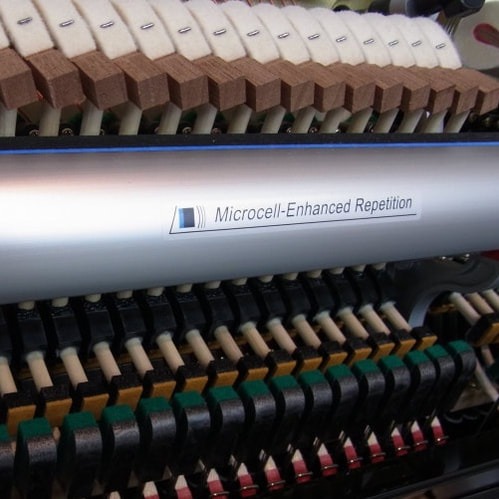 A wooden action upright piano can repeat a note roughly 6 times per second. For contrast, a wooden action grand piano can repeat 12 notes per second. With the use of composite action parts, Kawai’s upright pianos can repeat notes 16% faster. However, on Kawai’s K-Series pianos, they use a microcell-enhanced material on the hammer rail which adds an additional 15-20% repetition speed. The result is an upright action that is capable of handling faster, more challenging musical pieces.
A wooden action upright piano can repeat a note roughly 6 times per second. For contrast, a wooden action grand piano can repeat 12 notes per second. With the use of composite action parts, Kawai’s upright pianos can repeat notes 16% faster. However, on Kawai’s K-Series pianos, they use a microcell-enhanced material on the hammer rail which adds an additional 15-20% repetition speed. The result is an upright action that is capable of handling faster, more challenging musical pieces.Industry-standard felt material used on the K-200
 The action rail is the “spine” of the piano’s action. It maintains the extremely precise geometry of the hammers in relation to the strings that is need for a consistent touch. Kawai’s hammer rail is in the shape of an “F” instead of an “L”. This adds significant additional resistance to twisting or warping over time. Also, the top surface, where the hammers are mounted, is serrated (some piano makers glue sandpaper here). The serrated surface will not wear away over time like sandpaper and will keep the hammers properly aligned over a longer period of time. This results in a more even wearing of the hammers and provides a more stable touch.
The action rail is the “spine” of the piano’s action. It maintains the extremely precise geometry of the hammers in relation to the strings that is need for a consistent touch. Kawai’s hammer rail is in the shape of an “F” instead of an “L”. This adds significant additional resistance to twisting or warping over time. Also, the top surface, where the hammers are mounted, is serrated (some piano makers glue sandpaper here). The serrated surface will not wear away over time like sandpaper and will keep the hammers properly aligned over a longer period of time. This results in a more even wearing of the hammers and provides a more stable touch. Action brackets are responsible for maintaining the alignment of the hammers and dampers to the strings. Even a sub-millimetre shift can diminish the touch significantly. Kawai upright pianos feature three die-cast aluminum action brackets. Because each die-cast action bracket is precisely formed the same every time, they minimize the potential for misaligned action parts. This results in a touch that remains more consistent over time.
Action brackets are responsible for maintaining the alignment of the hammers and dampers to the strings. Even a sub-millimetre shift can diminish the touch significantly. Kawai upright pianos feature three die-cast aluminum action brackets. Because each die-cast action bracket is precisely formed the same every time, they minimize the potential for misaligned action parts. This results in a touch that remains more consistent over time. Found on the K-500 and K-800 models, Kawai’s exclusive NEOTEX™ key surface material offers the smooth, understated texture of natural ivory and ebony and a semi-porous surface to absorb the hand’s natural oils and perspiration. Since NEOTEX resists cracking and fading over years of use and is static-resistant to help prevent the build-up of unwanted dust. The result is a beautiful, long-lasting key surface with exceptional playability.
Found on the K-500 and K-800 models, Kawai’s exclusive NEOTEX™ key surface material offers the smooth, understated texture of natural ivory and ebony and a semi-porous surface to absorb the hand’s natural oils and perspiration. Since NEOTEX resists cracking and fading over years of use and is static-resistant to help prevent the build-up of unwanted dust. The result is a beautiful, long-lasting key surface with exceptional playability. Spruce is the ideal material for piano keys – light, yet extremely strong. It responds with minimal flex and great consistency, transmitting the subtle nuances of the pianist’s performance while remaining stable through years of heavy use. On Kawai’s K-Series, the length of each key has been extended, providing a more even response from the front to the back of the playing surface. This gives the pianist more control while playing softly.
Spruce is the ideal material for piano keys – light, yet extremely strong. It responds with minimal flex and great consistency, transmitting the subtle nuances of the pianist’s performance while remaining stable through years of heavy use. On Kawai’s K-Series, the length of each key has been extended, providing a more even response from the front to the back of the playing surface. This gives the pianist more control while playing softly.Extended keys also found on the ST-1
TONE
If the touch of a piano is like a steering wheel, then the tone of a piano would be the engine. Without the engine, a car is of little practical value. It is the same with pianos. If a piano has a good tone, it is a joy to play. If it has a superb tone… you’re off to the races. Materials and design have an enormous impact on the quality of a piano’s tone. Kawai’s grand pianos are renowned worldwide for their expressive tone and expansive dynamic range. Here are some of the reasons why.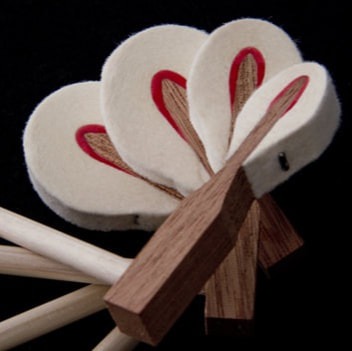 Kawai constructs its piano hammer mouldings using premium wool felt. Their K-Series and Institutional Series use mahogany hammers with a second layer of dense underfelt (for added tonal stability). The lighter weight of mahogany helps the hammers release faster after striking the strings which allows the strings to vibrate longer. This results in a more robust tone. Kawai’s K-15 and ND-21 use hard maple hammers, which are industry standard.
Kawai constructs its piano hammer mouldings using premium wool felt. Their K-Series and Institutional Series use mahogany hammers with a second layer of dense underfelt (for added tonal stability). The lighter weight of mahogany helps the hammers release faster after striking the strings which allows the strings to vibrate longer. This results in a more robust tone. Kawai’s K-15 and ND-21 use hard maple hammers, which are industry standard. The soundboard is the heart of a piano’s tone. Kawai only uses straight-grained solid spruce for its uptight piano soundboards. Spruce is the preferred choice of wood for use in piano soundboards as its properties ensure exceptional dynamic range and outstanding tonal balance across the entire sound spectrum. The K-series and Institutional-series have tapered soundboards which are designed to improve the dispersement of the string vibrations throughout the soundboard. That results in an even richer, fuller, more consistent resonant tone.
The soundboard is the heart of a piano’s tone. Kawai only uses straight-grained solid spruce for its uptight piano soundboards. Spruce is the preferred choice of wood for use in piano soundboards as its properties ensure exceptional dynamic range and outstanding tonal balance across the entire sound spectrum. The K-series and Institutional-series have tapered soundboards which are designed to improve the dispersement of the string vibrations throughout the soundboard. That results in an even richer, fuller, more consistent resonant tone. A piano’s soundboard is placed under tension to create a slight curvature or “crown” that dramatically increases the production of sound. Kawai pianos feature ribs that are engineered to distribute sound energy evenly across the soundboard to optimize its tone-producing capabilities. The K-Series take it a step further, using full-length ribs that are securely notched into the rim liner on all sides to better preserve the soundboard’s crown over time and to better utilize every inch of the soundboard’s potential.
A piano’s soundboard is placed under tension to create a slight curvature or “crown” that dramatically increases the production of sound. Kawai pianos feature ribs that are engineered to distribute sound energy evenly across the soundboard to optimize its tone-producing capabilities. The K-Series take it a step further, using full-length ribs that are securely notched into the rim liner on all sides to better preserve the soundboard’s crown over time and to better utilize every inch of the soundboard’s potential.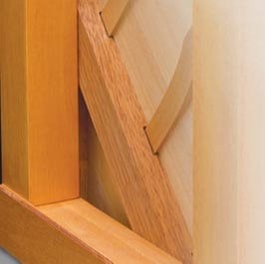 Energy reflecting contour bars are used on the K-Series and Institutional-Series uprights. They reshape the speaking area of the soundboard to resemble the contour of a grand piano’s soundboard by reflecting sound energy back into the centre, creating increased tonal power and sustain.
Energy reflecting contour bars are used on the K-Series and Institutional-Series uprights. They reshape the speaking area of the soundboard to resemble the contour of a grand piano’s soundboard by reflecting sound energy back into the centre, creating increased tonal power and sustain. Duplex scaling provides additional harmonics when a note is played. It adds clarity to thunderous bass notes and a chine to the treble section. Duplex scaling works by allowing the extreme ends of the piano’s strings to vibrate and produce harmonics that enhance tone. Kawai’s dual duplex design utilizes two duplex scale regions for an added measure of harmonic richness, brilliance, complexity and sustain.
Duplex scaling provides additional harmonics when a note is played. It adds clarity to thunderous bass notes and a chine to the treble section. Duplex scaling works by allowing the extreme ends of the piano’s strings to vibrate and produce harmonics that enhance tone. Kawai’s dual duplex design utilizes two duplex scale regions for an added measure of harmonic richness, brilliance, complexity and sustain.An upper duplex scale is found on the K-500. A dual duplex scale is found on the K-800.
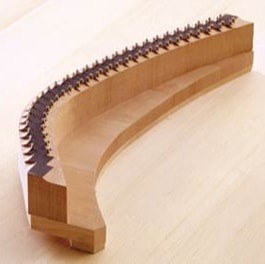 The bridge performs the vital task of transferring the vibrations of the strings to the soundboard. Kawai uprights have individually-notched hard maple bridges. These bridges help to ensure correct string tension and optimize tonal transfer.
The bridge performs the vital task of transferring the vibrations of the strings to the soundboard. Kawai uprights have individually-notched hard maple bridges. These bridges help to ensure correct string tension and optimize tonal transfer. Hard brass agraffes, positioned through precise CNC drilling of the iron plate, ensure accuracy of string alignment, spacing and down-bearing pressure for the greatest uniformity of tone. They also allow the most precise measurement of “speaking length” for the strings and provide smooth string movement for ease of tuning.
Hard brass agraffes, positioned through precise CNC drilling of the iron plate, ensure accuracy of string alignment, spacing and down-bearing pressure for the greatest uniformity of tone. They also allow the most precise measurement of “speaking length” for the strings and provide smooth string movement for ease of tuning.Agraffes are found on the K-800
STRENGTH
The strength of a well-crafted piano is one of the most impressive examples of the union between engineering and art in the world today. Kawai’s uprights are designed and crafted with great care to ensure each piano has the strength to produce and maintain their superb touch and tone over time. On an upright piano, the soundboard is supported by back posts. These posts help retain structural rigidity, maximizing the amount of string vibration channeled towards the soundboard. Greater rigidity equals greater tone and power. All Kawai upright pianos have a minimum of four back posts. Kawai also uses a proprietary “matched strength” iron plate which matches the strength and mass of each plate to the scale design of each individual model. These features combine to create a well-balanced back assembly that provides the foundation for outstanding tone.
On an upright piano, the soundboard is supported by back posts. These posts help retain structural rigidity, maximizing the amount of string vibration channeled towards the soundboard. Greater rigidity equals greater tone and power. All Kawai upright pianos have a minimum of four back posts. Kawai also uses a proprietary “matched strength” iron plate which matches the strength and mass of each plate to the scale design of each individual model. These features combine to create a well-balanced back assembly that provides the foundation for outstanding tone. Found on Kawai’s K-Series, plate bolts strengthen the connection between the plate and back posts. This increases structural stability and improves the transfer of vibrational energy to the soundboard which ultimately enhances the tone and power of the piano.
Found on Kawai’s K-Series, plate bolts strengthen the connection between the plate and back posts. This increases structural stability and improves the transfer of vibrational energy to the soundboard which ultimately enhances the tone and power of the piano. The pinblock in a piano has the essential job of anchoring the tuning pins which in turn keep tension on the strings. Kawai upright pianos use a proprietary multi-grip pinblock which is multi-laminated with cross-banded layers of North American hard maple to provide consistent torque and provide enough strength to resist the 36,000 pounds of string tension. The steel tuning pins are machine-threaded for maximum bi-directional torque and nickel plated to provide long-term protection.
The pinblock in a piano has the essential job of anchoring the tuning pins which in turn keep tension on the strings. Kawai upright pianos use a proprietary multi-grip pinblock which is multi-laminated with cross-banded layers of North American hard maple to provide consistent torque and provide enough strength to resist the 36,000 pounds of string tension. The steel tuning pins are machine-threaded for maximum bi-directional torque and nickel plated to provide long-term protection. A piano’s keyslip is the long, horizontal piece of wood that covers the front faces of the keys. Because it is made of wood, a keyslip can war or bend with changes in humidity causing keys to stick. To eliminate this problem, a heavy-gauge steel angle iron is added to prevent warping or bending in any direction. Keys move freely with virtually no possibility of rubbing or sticking against the keyslip.
A piano’s keyslip is the long, horizontal piece of wood that covers the front faces of the keys. Because it is made of wood, a keyslip can war or bend with changes in humidity causing keys to stick. To eliminate this problem, a heavy-gauge steel angle iron is added to prevent warping or bending in any direction. Keys move freely with virtually no possibility of rubbing or sticking against the keyslip.Steel-reinforced keys lips can be found on the K-Series
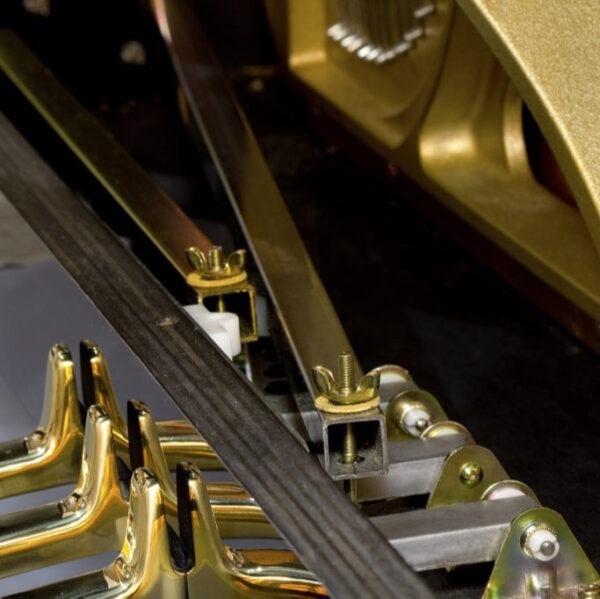 Square-tube pedal levers are stronger than their lower-cost round-tube counterparts. In addition to being stronger, they help prevent unwanted pedal “squeaks” and enable a more stable pedal adjustment.
Square-tube pedal levers are stronger than their lower-cost round-tube counterparts. In addition to being stronger, they help prevent unwanted pedal “squeaks” and enable a more stable pedal adjustment.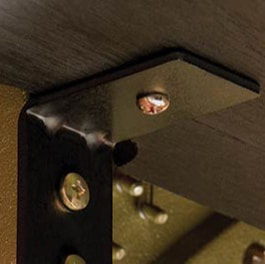 A piano’s keybed must be strong enough to resist warping over years of use. A keybed that is not flat allows the action to “rock”, losing energy and making the touch inconsistent. Kawai uptight keypads are made with sturdy laminated hardwoods and reinforced by rear braces on the iron frame that help to ensure stable placement and add rigidity.
A piano’s keybed must be strong enough to resist warping over years of use. A keybed that is not flat allows the action to “rock”, losing energy and making the touch inconsistent. Kawai uptight keypads are made with sturdy laminated hardwoods and reinforced by rear braces on the iron frame that help to ensure stable placement and add rigidity.Rear braces not found on the K-15
 It may seem a bit underwhelming to tout a machine screw as a feature of a piano, but it is worth noting that many of the part tolerances in a piano action are sub-millimetre. Kawai uses machine screws instead of self-tapping screws to secure action components such as the hammers and action rails. Machine screws have more thread and don’t lose strength when repeatedly loosened and tightened, unlike self-tapping screws. Machine screws cost more and add time to the piano building process, which is why many piano makers choose not to use them.
It may seem a bit underwhelming to tout a machine screw as a feature of a piano, but it is worth noting that many of the part tolerances in a piano action are sub-millimetre. Kawai uses machine screws instead of self-tapping screws to secure action components such as the hammers and action rails. Machine screws have more thread and don’t lose strength when repeatedly loosened and tightened, unlike self-tapping screws. Machine screws cost more and add time to the piano building process, which is why many piano makers choose not to use them.
machine screw on left, self-tapping screw on right
CHARACTER
Though the essence of a grand piano is its tone and touch, it is the little details that add a level of sophistication. From utility-based details such as the “soft-Fall” fallboard to aesthetic details such as cast brass pedals, Kawai continues to produce upright pianos with character. The fallboard is designed with a dual-damping mechanism so sensitive that it was dubbed “soft fall”. The ultra-slow closing system protects hands, fingers and the piano’s finish from the harm that a jarring close might cause.
The fallboard is designed with a dual-damping mechanism so sensitive that it was dubbed “soft fall”. The ultra-slow closing system protects hands, fingers and the piano’s finish from the harm that a jarring close might cause. Conveniently built into the fallboard, the music rack on the K-200, K-300, and K-500 extends nearly forty inches to accommodate large scores and pages of sheet music. The K-400 and K-800 have a “grand-style” music rack which offers a more stately aesthetic. All K-series music racks are felted to keep the music from sliding off. The ST-1 has a staggering 47″ dedicated music rack.
Conveniently built into the fallboard, the music rack on the K-200, K-300, and K-500 extends nearly forty inches to accommodate large scores and pages of sheet music. The K-400 and K-800 have a “grand-style” music rack which offers a more stately aesthetic. All K-series music racks are felted to keep the music from sliding off. The ST-1 has a staggering 47″ dedicated music rack.The K-15 and ND-21 have industry-standard music racks
 Kawai’s proprietary casting process binds molten brass to a sturdy steel pedal resulting in strong-beautiful pedals that are built to last the lifetime of the piano.
Kawai’s proprietary casting process binds molten brass to a sturdy steel pedal resulting in strong-beautiful pedals that are built to last the lifetime of the piano.Chrome pedals found on the ND-21
 Kawai’s K-Series has front casters made of solid brass, which are as sturdy as they are attractive. Double casters are used for the larger models. The ND-21 and ST-1 use double rubber casters to better withstand being moved regularly.
Kawai’s K-Series has front casters made of solid brass, which are as sturdy as they are attractive. Double casters are used for the larger models. The ND-21 and ST-1 use double rubber casters to better withstand being moved regularly. Every Kawai upright piano is covered by a ten year fully transferrable warranty. The warranty covers defects of materials and workmanship. If problems occur related to the piano’s original materials or factory assembly, such issues are covered, even to the point of full replacement if a problem cannot be corrected.
Every Kawai upright piano is covered by a ten year fully transferrable warranty. The warranty covers defects of materials and workmanship. If problems occur related to the piano’s original materials or factory assembly, such issues are covered, even to the point of full replacement if a problem cannot be corrected.Kawai’s Grand Pianos In Depth
With approximately 9,000 moving parts, the piano may be the most complicated acoustic instrument ever built. There are dozens of components that must work in
Kawai’s Digitals: Part 5 – The Rest
PART V: THE REST Beyond simply being played as an instrument, digital pianos have other features that can enhance the musical experience. With built-in lesson
Kawai’s Digitals: Part 4 – Connectivity
PART IV: CONNECTIVITY The ability to connect with technology is one of the advantages of a digital piano. From using your piano as a Bluetooth
Kawai’s Digitals: Part 3 – Piano Realism
PART III: PIANO REALISM The last two articles have explored the various Kawai actions and sound technologies. Touch and tone are paramount to any piano,
Kawai’s Digitals: Part 1 – Actions
PART I: DIGITAL PIANO ACTIONS The importance of a digital piano’s action cannot be understated. The ability to play dynamically is what makes a piano
Kawai’s Digitals: Part 2 – Sound Technology
PART II: SOUND TECHNOLOGY Playing a piano can be a rewarding experience. The slightest change of pressure applied to a key not only affects the
Kawai’s Upright Pianos In Depth
To put pianos into perspective, an average automobile engine has around 300 parts, a violin has 90, a microscope has 14, and a piano has
Kawai Digital Comparison Chart
Digital pianos are always evolving. Kawai makes a real effort to advance the realism of digital pianos. Though their work is impressive and exciting, it

